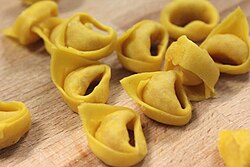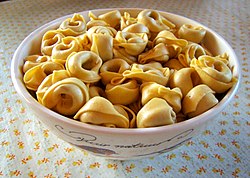You can help expand this article with text translated from the corresponding article in Italian. (June 2024)Click [show] for important translation instructions.
|
 The distinctive shape of tortellini | |
| Type | Pasta |
|---|---|
| Place of origin | Italy |
| Region or state | Emilia-Romagna |
| Variations | Tortelloni |
Tortellini is a type of stuffed pasta typical of the Italian cities of Bologna and Modena, in the Emilia-Romagna region. Traditionally it is stuffed with a mix of meat (pork loin, prosciutto, mortadella), Parmesan cheese, egg, and nutmeg and served in capon broth (in brodo di cappone). [1]

